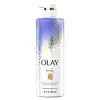What's inside
What's inside
 Key Ingredients
Key Ingredients

 Benefits
Benefits

 Concerns
Concerns

 Ingredients Side-by-side
Ingredients Side-by-side

Water
Skin ConditioningPetrolatum
EmollientSodium Trideceth Sulfate
CleansingSodium Chloride
MaskingCocamidopropyl Betaine
CleansingTrideceth-3
EmulsifyingParfum
MaskingNiacinamide
SmoothingRetinol
Skin ConditioningRetinyl Propionate
Skin ConditioningSodium Citrate
BufferingGuar Hydroxypropyltrimonium Chloride
Skin ConditioningSodium Benzoate
MaskingXanthan Gum
EmulsifyingGlyceryl Oleate
EmollientCitric Acid
BufferingDisodium EDTA
Sodium Hydroxide
BufferingAcrylates/C10-30 Alkyl Acrylate Crosspolymer
Emulsion StabilisingMethylchloroisothiazolinone
PreservativeMethylisothiazolinone
PreservativeCI 19140
Cosmetic ColorantCI 17200
Cosmetic ColorantWater, Petrolatum, Sodium Trideceth Sulfate, Sodium Chloride, Cocamidopropyl Betaine, Trideceth-3, Parfum, Niacinamide, Retinol, Retinyl Propionate, Sodium Citrate, Guar Hydroxypropyltrimonium Chloride, Sodium Benzoate, Xanthan Gum, Glyceryl Oleate, Citric Acid, Disodium EDTA, Sodium Hydroxide, Acrylates/C10-30 Alkyl Acrylate Crosspolymer, Methylchloroisothiazolinone, Methylisothiazolinone, CI 19140, CI 17200
Water
Skin ConditioningSodium C14-16 Olefin Sulfonate
CleansingCocamidopropyl Hydroxysultaine
CleansingSodium Cocoyl Glutamate
CleansingGlycerin
HumectantPyrus Malus Fruit Extract
Skin ConditioningLactic Acid
BufferingGlycolic Acid
BufferingSalicylic Acid
MaskingSodium Chloride
MaskingPropanediol
SolventEucalyptus Globulus Leaf Oil
PerfumingDecyl Glucoside
CleansingAcrylates Crosspolymer-4
Emulsion StabilisingCitric Acid
BufferingPhenoxyethanol
PreservativeMentha Piperita Oil
MaskingCaprylyl Glycol
EmollientEthylhexylglycerin
Skin ConditioningHexylene Glycol
EmulsifyingSodium Hydroxide
BufferingLimonene
PerfumingTetrasodium Glutamate Diacetate
Linalool
PerfumingWater, Sodium C14-16 Olefin Sulfonate, Cocamidopropyl Hydroxysultaine, Sodium Cocoyl Glutamate, Glycerin, Pyrus Malus Fruit Extract, Lactic Acid, Glycolic Acid, Salicylic Acid, Sodium Chloride, Propanediol, Eucalyptus Globulus Leaf Oil, Decyl Glucoside, Acrylates Crosspolymer-4, Citric Acid, Phenoxyethanol, Mentha Piperita Oil, Caprylyl Glycol, Ethylhexylglycerin, Hexylene Glycol, Sodium Hydroxide, Limonene, Tetrasodium Glutamate Diacetate, Linalool
 Reviews
Reviews

Ingredients Explained
These ingredients are found in both products.
Ingredients higher up in an ingredient list are typically present in a larger amount.
Citric Acid is an alpha hydroxy acid (AHA) naturally found in citrus fruits like oranges, lemons, and limes.
Like other AHAs, citric acid can exfoliate skin by breaking down the bonds that hold dead skin cells together. This helps reveal smoother and brighter skin underneath.
However, this exfoliating effect only happens at high concentrations (20%) which can be hard to find in cosmetic products.
Due to this, citric acid is usually included in small amounts as a pH adjuster. This helps keep products slightly more acidic and compatible with skin's natural pH.
In skincare formulas, citric acid can:
While it can provide some skin benefits, research shows lactic acid and glycolic acid are generally more effective and less irritating exfoliants.
Most citric acid used in skincare today is made by fermenting sugars (usually from molasses). This synthetic version is identical to the natural citrus form but easier to stabilize and use in formulations.
Read more about some other popular AHA's here:
Learn more about Citric AcidChances are, you eat sodium chloride every day. Sodium Chloride is also known as table salt.
This ingredient has many purposes in skincare: thickener, emulsifier, and exfoliator.
You'll most likely find this ingredient in cleansers where it is used to create a gel-like texture. As an emulsifier, it also prevents ingredients from separating.
There is much debate on whether this ingredient is comedogenic. The short answer - comedogenic ratings don't tell the whole story. Learn more about comegodenic ratings here.
The concensus about this ingredient causing acne seems to be divided. Research is needed to understand if this ingredient does cause acne.
Scrubs may use salt as the primary exfoliating ingredient.
Learn more about Sodium ChlorideSodium Hydroxide is also known as lye or caustic soda. It is used to adjust the pH of products; many ingredients require a specific pH to be effective.
In small amounts, sodium hydroxide is considered safe to use. However, large amounts may cause chemical burns due to its high alkaline.
Your skin has a natural pH and acid mantle. This acid mantle helps prevent harmful bacteria from breaking through. The acid mantle also helps keep your skin hydrated.
"Alkaline" refers to a high pH level. A low pH level would be considered acidic.
Learn more about Sodium HydroxideWater. It's the most common cosmetic ingredient of all. You'll usually see it at the top of ingredient lists, meaning that it makes up the largest part of the product.
So why is it so popular? Water most often acts as a solvent - this means that it helps dissolve other ingredients into the formulation.
You'll also recognize water as that liquid we all need to stay alive. If you see this, drink a glass of water. Stay hydrated!
Learn more about Water